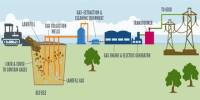The shoreline is shielded by barrier islands from storms, storm surge, waves, and flooding. They might serve as a barrier between seaside real estate and the water. Barrier islands recede or migrate closer to the shore when sea levels rise, reducing the buffer and protection.
Even if sea level rises at the current rate, according to new findings published today, coastal barrier islands will retreat by 50% within a century.
“These findings can be applied all over the world, but they may be particularly significant in the U.S., where houses are being built extremely close to the beach,” said LSU Department of Oceanography & Coastal Sciences and Center for Computation and Technology Associate Professor Giulio Mariotti, who is the lead author of the paper published today in Nature Geoscience.
“It is well known that barrier islands retreat as sea level rises, but it has not been clear how,” Mariotti said.
Barrier island retreat has not grown as much as sea level rise, according to Mariotti and co-author Christopher Hein of the Virginia Institute of Marine Science.
The first computer model to demonstrate a more complex relationship between sea level rise and barrier island retreat than earlier models was created by Mariotti, who studied this issue.
The conventional wisdom that barrier islands respond instantly to sea level rise is challenged by the new model, which demonstrates a lag between sea level increase and barrier island retreat.
“One reason previous models didn’t see the lag was because they assumed the geometry of the whole coastal tract from the lower continental shelf to the upland boundary, including subaerial barriers, inlets, and tidal channels was frozen. However, the geometry can change and that’s what’s enabling this lag effect,” he said.
Because these islands are almost entirely undeveloped, they are among the most dynamic in the world. This study shows that we are seeing out there today is only a hint of what is to come, given increasing rates of sea-level rise; and what is likely in store for developed islands globally in the absence of ever-accelerating beach nourishment and hardening.
Giulio Mariotti
According to the model, the rate of retreat of barrier islands will rise by 50% during the next 100 years.
Additionally, barrier island retreat might accelerate further if the rate of sea level rise quickens. It’s crucial to remember that these forecasts do not account for storm intensity and frequency, which can also accelerate the retreat of barrier islands.
Mariotti developed the model using the Virginia Barrier Islands, a group of uninhabited islands off the southeast coast of the Delmarva Peninsula.
Hein notes that, “because these islands are almost entirely undeveloped, they are among the most dynamic in the world. This study shows that we are seeing out there today is only a hint of what is to come, given increasing rates of sea-level rise; and what is likely in store for developed islands globally in the absence of ever-accelerating beach nourishment and hardening.”
Although this model forecasts an increase in retreat, Mariotti also points out that barrier islands vary and that some may retreat from the shore more quickly than others or perhaps migrate away entirely.
“One of the most original parts of this model is it can run simulations over thousands of years but can also provide insights into decades, which is more interesting for management. At the same time, I can also run simulations over centuries and millennia, which allows the results to be compared with geologic data,” Mariotti said.
















